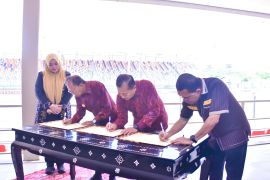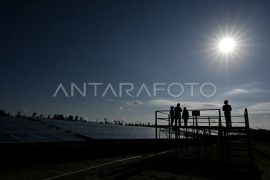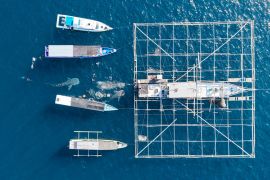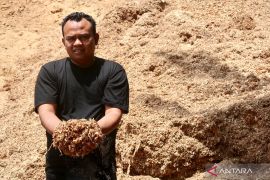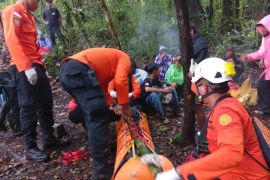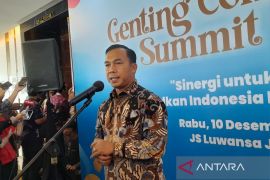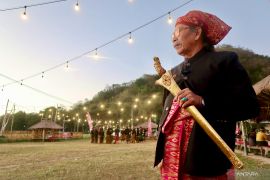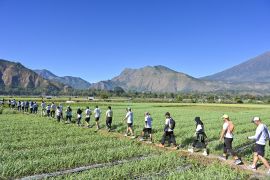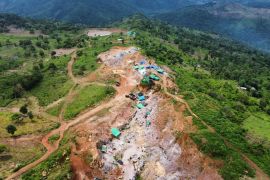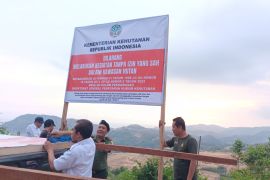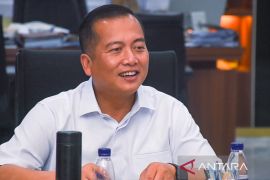Behind her, there were six pieces of woven fabrics in various colors displayed on wooden hangers.
“Bima weaving still use this gedogan method, while other weaving already use machines,” she explained.
For the people of Bima, West Nusa Tenggara, weaving skills must be mastered not only by women but also men.
Nita, who has been weaving since she was in elementary school, is now in her early 30s and a mother of two.
She demonstrated her skills at the Lombok Sumbawa Weaving Festival held in Mataram, West Nusa Tenggara, on August 24 and 25, 2024.
Held by Bank Indonesia, the event aimed to preserve the weaving tradition amid the mass-produced fast fashion.
The activity of weaving with traditional gedogan is an effort to maintain the tradition of the people of West Nusa Tenggara.
The sound of belida wood beating like a musical instrument and drifting to all corners, compacting the thread embroidery. Skillful hand movements using suri are a sign of perseverance forged by time and patience.
For the Bima people residing in the eastern region of Sumbawa Island in West Nusa Tenggara, weaving is not just a means to fulfill the need for clothes, but also symbolizes the three main strengths of the human soul — creativity, feeling, and will.
Each piece of woven fabric reflects the soul of the craftsperson and the environmental conditions. That is why woven motifs often tend to depict flowers, plants, and traditional houses.
A journal on the development of Bima woven fabric motifs from the Department of Industrial Technology, Ganesha University of Education, reveals that woven cloth made by craftspersons not only serves functional purposes or traditional aspects, but is also made based on social, aesthetic, and economic considerations.
Nita—who has been weaving for two decades—said that the process of making a piece of Bima woven cloth measuring 60 centimeters in width and 4 meters in length takes 4 to 5 days.
A piece of woven cloth sells for Rp800 thousand. If the motif is complicated and uses natural dyes from plants, then the price of the piece of woven cloth can reach millions of rupiahs.
Woven cloth is the embodiment of a work of art wrapped in deeply rooted cultural elements. Each piece of woven cloth relates stories of civilization and livelihood.
From cotton to fabric
Based on the Indonesian Plantation Statistics published by the Ministry of Agriculture, cotton plantation and production in West Nusa Tenggara fluctuated in the period from 2018 to 2020.
In 2018, the area under cotton plantation in West Nusa Tenggara was recorded at 945 hectares with a harvest area of 258 hectares, which only produced 46 tons of cotton.
A year later, the area under cotton plantation shrank drastically to 200 hectares with a harvest area of 395 hectares. The volume of cotton production at that time was recorded at 70 tons.
In 2020, cotton production in West Nusa Tenggara fell to 68 tons with the planting area and harvest area measuring 150 hectares.
The decrease in agricultural land due to the expansion of residential development and public facilities and offices as well as the cultivation of cotton being less popular than growing food crops are factors that have made cotton cultivation less promising in the eyes of farmers.
Cotton is an important component in the industrialization of weaving. In 2019, cotton produced in West Nusa Tenggara, especially Lombok, was sold to Bali at a low price.
In Bali, the cotton was formed into yarn and then bought at a high price by weavers in Lombok and Sumbawa.
The establishment of a clothing house in Giri Tembesi village—known as the cotton village of West Lombok Regency—is aimed at spurring progress at cotton plantations on an industrial scale in West Nusa Tenggara.
Currently, all processes — starting from collecting cotton, spinning it into yarn, and weaving fabric — can be done independently by local residents.
Sourcing raw materials directly from farmers is certainly cheaper and has a lower carbon footprint than using raw materials imported from outside the region, let alone abroad.
If the industrialization of weaving continues to be taken up and expanded, but is not balanced by improvements in the upstream sector—cotton and yarn—it has the potential to threaten the industrialization mission because the production of raw materials will not be sufficient to meet industrial demand and therefore, imported raw materials will need to be brought in from abroad.
The concrete steps that must now be taken are to expand the planting area and increase cotton production to support the industrialization of weaving in West Nusa Tenggara.
Developing derivative products
An economist from the University of Mataram, Muhammad Firmansyah, said that weaving is a hereditary craft and now, the public considers it as a business opportunity because of the uniqueness of the finished product.
In terms of comparative advantage, weaving already has an advantage because of its special nature. However, weaving does not yet have a competitive advantage because of the relatively high price tag.
For weaving to become a competitive product, production costs in the form of labor, processing time, and raw material prices must be minimized as much as possible.
The local content of weaving is only in the manufacturing process, while the raw materials in the form of yarn are mostly still imported from other countries, such as China and India. This is the reason why the price of woven fabric per sheet is not cheap, thus it can only be enjoyed by the middle and upper classes.
In the business tree, market segmentation is very important so that traditional fabric products can reach all levels of consumers.
Even a famous fashion brand that sells suits for millions of rupiahs also produces handkerchiefs that are sold for just tens of thousands of rupiahs. The weaving industry must learn how to create a broad market at prices affordable for all groups.
The unique cultural value of woven fabrics is certainly not enough as capital to survive amidst the varied and dynamic competition of the fashion industry.
Through the creative spaces of designers, woven fabrics have slowly begun to spread into various derivative products such as clothes, pants, bags, and souvenirs.
The process of weaving is no longer limited to sheets of cloth or sarongs. Weaving has transformed into a simpler mode.
The slogan “Proudly Made in Indonesia” has also strengthened the enthusiasm of designers and weavers in creating various creative modes that are replete with cultural values, but also competitive in terms of price.
Makers of woven fabrics must be able to take advantage of opportunities in the global fashion industry. The fashion trend that utilizes weaving is a magnet for both the older and younger generations.
A piece of intact woven fabric that was originally sold for millions of rupiahs and could only be purchased by certain groups must also be enjoyed by the lower classes through various derivative products.
The woven market must be expanded and made more inclusive, in line with the massive development of the current fashion industry.
Related news: Ikat integral part of Sumba people's lives: ministry
Related news: Ministry collecting data on woven textile ecosystem of East Sumba
Related news: Ministry reiterates commitment to preserving traditional fabric art
Editor: Azis Kurmala
Copyright © ANTARA 2024

